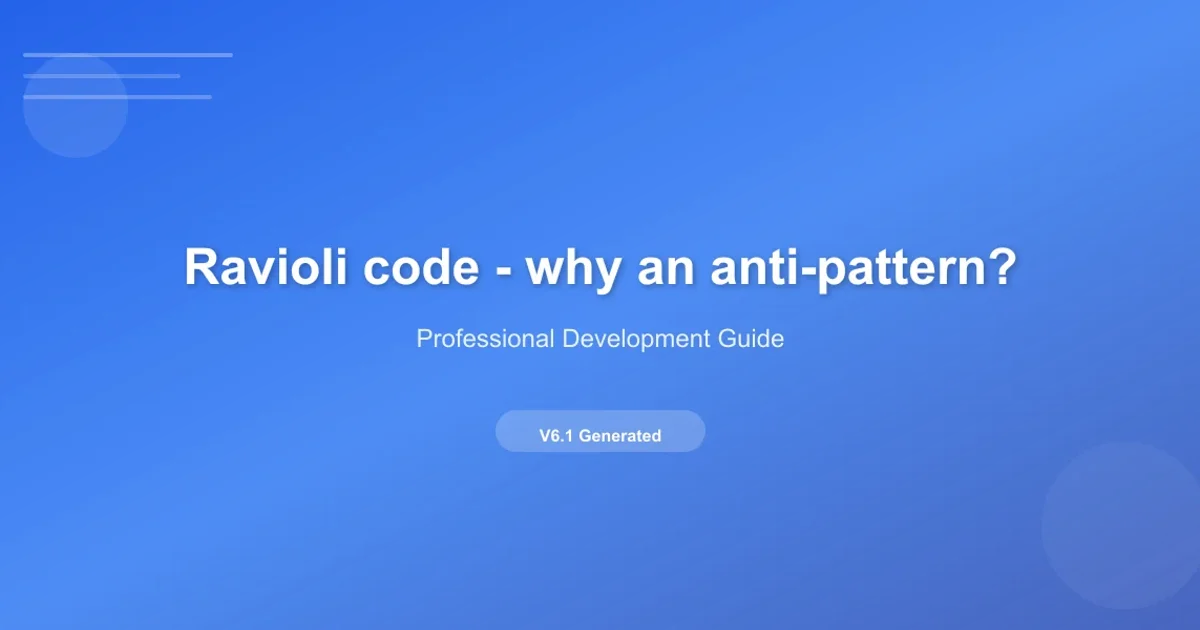Ravioli code - why an anti-pattern?
Categories:
Ravioli Code: Understanding and Avoiding This Anti-Pattern

Explore the 'Ravioli Code' anti-pattern, characterized by an excessive number of small, tightly coupled, and often redundant components. Learn why it hinders maintainability, readability, and scalability, and discover strategies to write cleaner, more cohesive code.
In software development, anti-patterns describe common solutions to problems that are ineffective and may lead to negative consequences. One such anti-pattern is 'Ravioli Code,' a term used to describe a codebase inundated with an excessive number of small, often trivial, and tightly coupled components. Just like a plate of ravioli, each piece might seem self-contained, but they are all very similar and often require a complex sauce (or orchestration logic) to make sense. This article delves into what Ravioli Code is, why it's detrimental to software projects, and how developers can identify and refactor it to promote healthier, more maintainable code.
What is Ravioli Code?
Ravioli Code is characterized by a system composed of numerous tiny classes, methods, or functions, each performing a very small, often single, operation. While the Single Responsibility Principle (SRP) advocates for components to have one reason to change, Ravioli Code takes this to an extreme, breaking down logic into units that are too granular. This often results in a proliferation of interfaces, abstract classes, and concrete implementations that add overhead without proportional benefit. The individual pieces might be simple, but their sheer number and intricate dependencies create a complex web that is difficult to navigate and understand.
flowchart TD
A[Main Application] --> B(Service Orchestrator)
B --> C1[Tiny Service 1]
B --> C2[Tiny Service 2]
B --> C3[Tiny Service 3]
C1 --> D1[Micro-Method A]
C1 --> D2[Micro-Method B]
C2 --> D3[Micro-Method C]
C3 --> D4[Micro-Method D]
subgraph Ravioli Code Example
C1
C2
C3
D1
D2
D3
D4
end
style C1 fill:#f9f,stroke:#333,stroke-width:2px
style C2 fill:#f9f,stroke:#333,stroke-width:2px
style C3 fill:#f9f,stroke:#333,stroke-width:2px
style D1 fill:#ccf,stroke:#333,stroke-width:2px
style D2 fill:#ccf,stroke:#333,stroke-width:2px
style D3 fill:#ccf,stroke:#333,stroke-width:2px
style D4 fill:#ccf,stroke:#333,stroke-width:2pxA conceptual diagram illustrating the excessive granularity and orchestration typical of Ravioli Code, where a main application orchestrates many tiny services and micro-methods.
Why is Ravioli Code an Anti-Pattern?
While modularity is generally a good thing, over-modularity, as seen in Ravioli Code, introduces several significant drawbacks:
- Increased Cognitive Load: Developers must navigate a vast number of files and classes to understand even simple functionalities. Tracing execution paths becomes a daunting task, as a single logical operation might span dozens of small methods and objects.
- Reduced Readability and Maintainability: The codebase becomes verbose and difficult to read. Small methods often have generic names, making their purpose unclear without examining their callers. Changes in one area might require modifications across many small, interconnected components, increasing the risk of introducing bugs.
- Performance Overhead: While often negligible in modern systems, the overhead of excessive method calls, object instantiation, and context switching can accumulate, especially in performance-critical applications.
- Boilerplate Proliferation: To manage the multitude of small components, developers often introduce more boilerplate code for dependency injection, configuration, and orchestration, further obscuring the actual business logic.
- Difficulty in Refactoring: The tight coupling between numerous small units makes large-scale refactoring efforts extremely challenging and risky. Changing an interface or a core component can have ripple effects across the entire system.
Identifying and Refactoring Ravioli Code
Recognizing Ravioli Code often involves looking for specific symptoms:
- Many small files: A directory with hundreds of files, each containing only a few lines of code.
- Deep call stacks: A simple operation requires calling through many layers of tiny methods.
- Excessive interfaces/abstractions: Interfaces with only one implementation, or abstract classes with minimal concrete differences.
- Anemic Domain Model: Domain objects that only hold data, with all business logic residing in separate 'service' classes.
- High coupling, low cohesion: Components are highly dependent on each other, but individual components don't encapsulate a meaningful chunk of functionality.
Refactoring Ravioli Code typically involves consolidating related functionalities. This might mean merging small methods into larger, more cohesive ones, combining classes that are overly granular, or introducing richer domain objects that encapsulate both data and behavior. The goal is to find the right balance of granularity, where components are small enough to be manageable but large enough to represent a meaningful unit of work.
public class OrderProcessor {
private final OrderValidator validator;
private final InventoryUpdater inventoryUpdater;
private final PaymentGateway paymentGateway;
private final NotificationService notificationService;
public OrderProcessor(OrderValidator validator, InventoryUpdater inventoryUpdater, PaymentGateway paymentGateway, NotificationService notificationService) {
this.validator = validator;
this.inventoryUpdater = inventoryUpdater;
this.paymentGateway = paymentGateway;
this.notificationService = notificationService;
}
public void processOrder(Order order) {
validator.validate(order);
inventoryUpdater.update(order);
paymentGateway.processPayment(order.getPaymentDetails());
notificationService.sendConfirmation(order);
}
}
// Example of overly granular components (Ravioli Code symptom)
public class OrderValidator {
public void validate(Order order) {
new OrderIdValidator().validate(order.getId());
new OrderItemsValidator().validate(order.getItems());
new ShippingAddressValidator().validate(order.getShippingAddress());
// ... many more tiny validators
}
}
public class OrderIdValidator {
public void validate(String orderId) { /* ... */ }
}
public class OrderItemsValidator {
public void validate(List<Item> items) { /* ... */ }
}